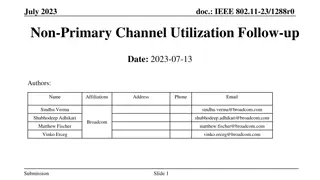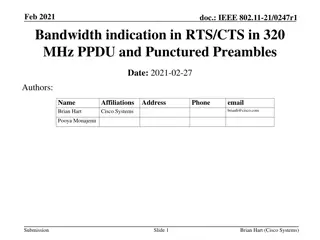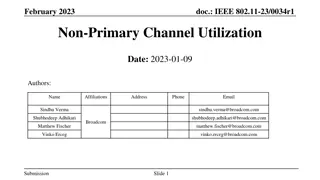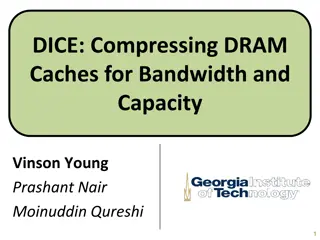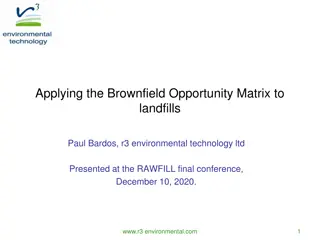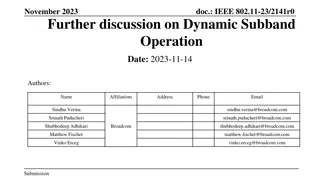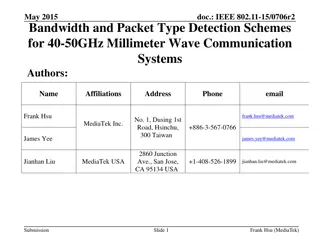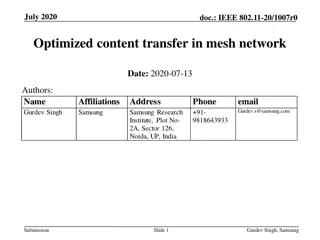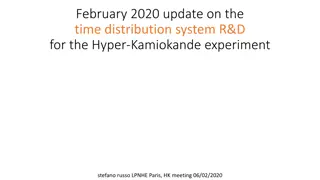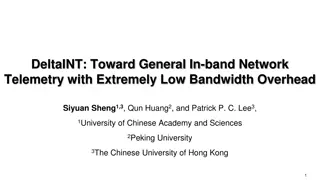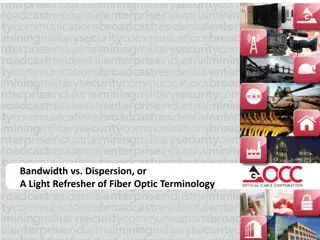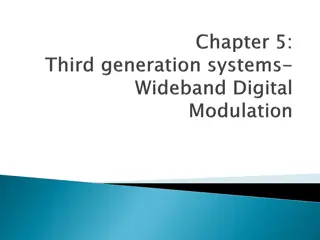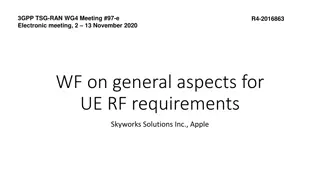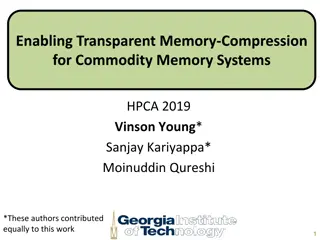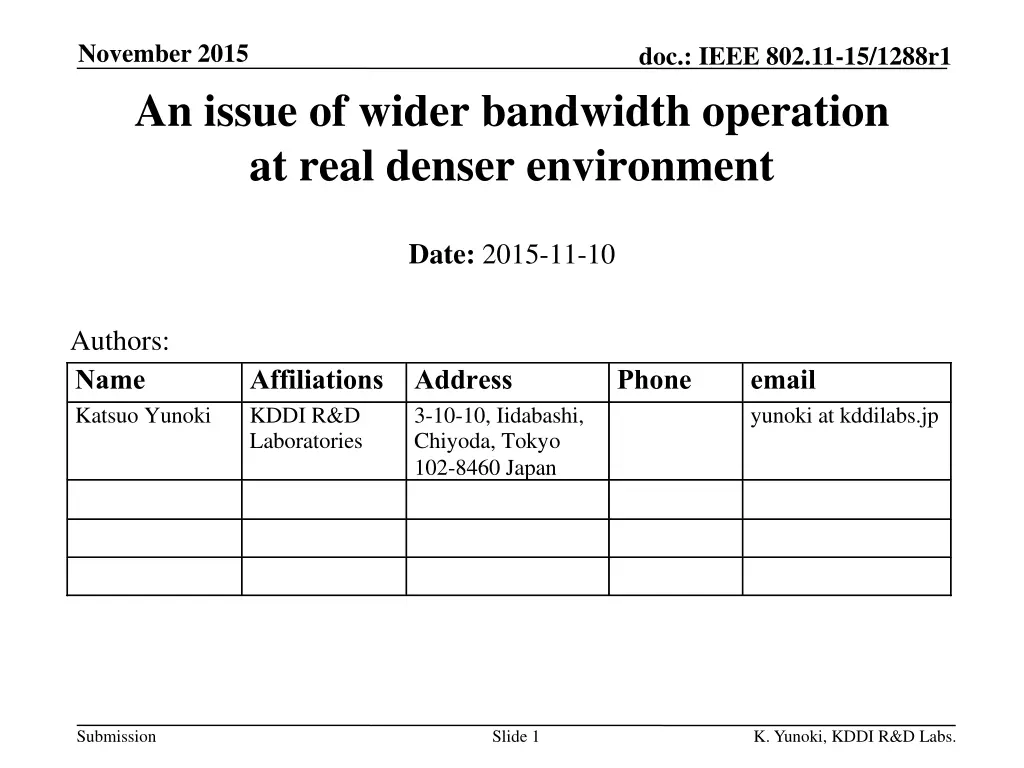
Optimizing Channel Selection Methods for Dense WLAN Environments
Discover the significance of adjusting bandwidth in crowded WLAN settings through real-world insights. Explore channel selection strategies, performance evaluations, and crucial considerations for enhancing public WLAN services in denser environments.
Download Presentation

Please find below an Image/Link to download the presentation.
The content on the website is provided AS IS for your information and personal use only. It may not be sold, licensed, or shared on other websites without obtaining consent from the author. If you encounter any issues during the download, it is possible that the publisher has removed the file from their server.
You are allowed to download the files provided on this website for personal or commercial use, subject to the condition that they are used lawfully. All files are the property of their respective owners.
The content on the website is provided AS IS for your information and personal use only. It may not be sold, licensed, or shared on other websites without obtaining consent from the author.
E N D
Presentation Transcript
November 2015 An issue of wider bandwidth operation at real denser environment doc.: IEEE 802.11-15/1288r1 Date: 2015-11-10 Authors: Name Katsuo Yunoki Affiliations Address KDDI R&D Laboratories Phone email yunoki at kddilabs.jp 3-10-10, Iidabashi, Chiyoda, Tokyo 102-8460 Japan Submission Slide 1 K. Yunoki, KDDI R&D Labs.
November 2015 doc.: IEEE 802.11-15/1288r1 Abstract This contribution shows real experiences on our public WLAN service at denser environment. Importance of bandwidth adjustment at such environment is explained from a standpoint of public WLAN operator. < Contents > 1. Review of channel selection methods 2. Examples of channel selection at denser environment 3. HT40/HT20 performance at denser environment 4. Evaluations in the laboratory 5. Considerations and proposal Submission Slide 2 K. Yunoki, KDDI R&D Labs.
November 2015 Channel selection methods for a VHT BSS [1] (Section 10.40.2, Draft P802.11 REVmc_D4.3) doc.: IEEE 802.11-15/1288r1 (1) Before a STA starts a VHT BSS, the STA shall perform a minimum of dot11VHTOBSSScanCount OBSS scan operations to search for existing BSSs. If an AP or a mesh STA starts a VHT BSS that occupies some or all channels of any existing BSSs, the AP or mesh STA may select a primary channel of the new VHT BSS that is identical to the primary channel of any one of the existing BSSs. If an AP or a mesh STA selects a primary channel for a new VHT BSS (abbr.) , then the selected primary channel meets the following conditions: - It shall not be identical to the secondary 20 MHz channel of any existing BSSs (abbr.) - It should not overlap with the secondary 40 MHz channel of any existing BSSs (abbr.) A STA that is an AP or mesh STA should not start a VHT BSS with a 20 MHz operating channel width on a channel that is the secondary 20 MHz channel of any existing BSSs (abbr.) , or is overlapped with the secondary 40 MHz channel of any existing BSSs (abbr.) (2) (3) (4) NOTE An AP or a mesh STA operating a VHT BSS with a 40 MHz, 80 MHz, 160 MHz, or 80+80 MHz operating channel width, on detecting an OBSS whose primary channel is the AP s or the mesh STA s secondary 20 MHz channel, might switch to 20 MHz BSS operation and/or move to a Submission different channel. Slide 3 K. Yunoki, KDDI R&D Labs.
November 2015 Channel selection methods for a HT BSS [1] (Section 10.16.3.2, Draft P802.11 REVmc_D4.3) doc.: IEEE 802.11-15/1288r1 (1) Before an AP or DO starts a 20/40 MHz BSS, it shall perform a minimum of dot11BSSWidthChannelTransitionDelayFactor OBSS scans to search for existing BSSs. (2) If the AP or DO starts a 20/40 MHz BSS in the 5 GHz band and the BSS occupies the same two channels as any existing 20/40 MHz BSSs, then the AP or DO shall select a primary channel of the new BSS that is identical to the primary channel of the existing 20/40 MHz BSSs and a secondary channel of the new 20/40 MHz BSS that is identical to the secondary channel of the existing 20/40 MHz BSSs, unless the AP discovers that on these two channels are existing 20/40 MHz BSSs with different primary and secondary channels. (3) An HT AP or a DO that is also an HT STA should not start a 20 MHz BSS in the 5 GHz band on a channel that is the secondary channel of a 20/40 MHz BSS. There must be a history which someone pointed out in the past that overlapped channel selection on the secondary channel of an existing BSS would give harmful impact to that BSS. Submission Slide 4 K. Yunoki, KDDI R&D Labs.
November 2015 Typical denser environment in Tokyo (Side of Shibuya station) doc.: IEEE 802.11-15/1288r1 Crowd in the evening (17:00, Oct. 20, Tue ) Bird s eye view Point-2 Point-1 Train station Denser square Point-2 Point-1 Real channel selections were monitored at 2 locations. Submission Slide 5 K. Yunoki, KDDI R&D Labs.
November 2015 doc.: IEEE 802.11-15/1288r1 CH selections (at Point-1) RSSI (dBm) HT40 HT40 HT40 HT40 (CH No.) 5500 5520 5540 5560 5580 5600 5620 5640 5660 5680 5700 (MHz) Submission Slide 6 K. Yunoki, KDDI R&D Labs.
November 2015 doc.: IEEE 802.11-15/1288r1 CH selections (at Point-1) RSSI (dBm) HT20 BSSs were found on the secondary 20M of HT40 OBSSs. HT40 HT40 HT40 HT40 (CH No.) 5500 5520 5540 5560 5580 5600 5620 5640 5660 5680 5700 (MHz) Submission Slide 7 K. Yunoki, KDDI R&D Labs.
November 2015 doc.: IEEE 802.11-15/1288r1 CH selections (at Point-2) RSSI (dBm) HT40 HT40 HT40 HT40 (CH No.) 5500 5520 5540 5560 5580 5600 5620 5640 5660 5680 5700 (MHz) Submission Slide 8 K. Yunoki, KDDI R&D Labs.
November 2015 doc.: IEEE 802.11-15/1288r1 CH selections (at Point-2) RSSI (dBm) HT20 BSSs were found on the secondary 20M of HT40 OBSSs. HT40 HT40 HT40 HT40 (CH No.) 5500 5520 5540 5560 5580 5600 5620 5640 5660 5680 5700 (MHz) Submission Slide 9 K. Yunoki, KDDI R&D Labs.
November 2015 doc.: IEEE 802.11-15/1288r1 HT40/HT20 comparison (TCP throughput CDF) @ 17:00-19:00, WED in different week at Shibuya 17 19 100% 90% 80% improved 70% 60% CDF 40MHz( ) HT40 (1st week) HT20 (2nd week) 50% 20MHz ( ) 40% 40% 30% Measured on the same BSS, but with different operating BW. 20% Some measurements were impossible. (HT40) 10% 1% 0% 0 1 2 3 4 5 6 7 8 9 10 11 12 13 14 15 16 17 18 19 20 21 22 23 24 [Mbps] Throughput [Mbps] Submission Slide 10 K. Yunoki, KDDI R&D Labs.
November 2015 doc.: IEEE 802.11-15/1288r1 Evaluation measurements in the laboratory TCP throughputs were measured. 3m RSSI : -70 -80dBm Shield box <Measured 11ac> desired signal PC PC AP1 interference 50cm Shield box Smart phone PC AP2 <Interfering 11ac> Submission Slide 11 K. Yunoki, KDDI R&D Labs.
November 2015 doc.: IEEE 802.11-15/1288r1 Results TCP throughput [Mbps] (Measured system) Channel selections for measurement 300 80MHz Measured sys. 250 Pri-20M Interfering sys. Case 1: Case 2: 200 20M 150 40kbps 0.4Mbps 100 Case 3: 2.8Mbps Case 4: 50 40M Case 5: 0 Case 6: Pri-20M 80M Case 7: (VHT20) with interference (VHT40) (VHT80) Pri-20M Submission Slide 12 K. Yunoki, KDDI R&D Labs.
November 2015 doc.: IEEE 802.11-15/1288r1 Observed frames Observed QoS Data frames (AP STA) were counted at each measurement. Frames were categorized by transmitted band width. (BW in VHT SIG-A) Through put (Mbps) Total QoS Data frames TX BW = 80M TX BW = 1st 40M TX BW = 1st 20M Inter- ference Qtty. Retries Qtty. Retries Qtty. Retries Qtty. Retries 340331 6% 1818 100% 0 - none 243 342149 6% 155273 23% 5234 46% 1 100% case1 61.3 160508 23% 0 - 71 76% 2393 87% case2 0.04 2464 87% 268 92% 6753 65% 10508 case3 2.8 17529 68% 69 6448 64% 143427 51% 19 84% case4 37.6 149894 51% 75799 25% 77701 21% 0 - case5 57.0 153500 23% case6 0.4 6066 66% 65 46% 1478 55% 4523 70% 211266 16% 13302 30% 0 - case7 126 224568 17% Extremely less Trying to transmit with narrower band widths Not well Submission Slide 13 K. Yunoki, KDDI R&D Labs.
November 2015 doc.: IEEE 802.11-15/1288r1 Bandwidth adjustments #1 (case 2) #2 (case 6) 80MHz 80MHz Before : (case 2) Before : (case 6) Pri-20M Pri-20M 20MHz 40MHz After : After : Pri-20M Throughput was improved. 0.04Mbps 78.8Mbps Throughput was improved. 0.4Mbps 86.7Mbps Bandwidth adjustment is very effective. Submission Slide 14 K. Yunoki, KDDI R&D Labs.
November 2015 doc.: IEEE 802.11-15/1288r1 Considerations The current standards have defined channel selection methods to avoid negative interference impacts among neighboring BSSs. However, implemented adjustment to narrower operating bandwidth doesn t work well when OBSS is detected on the secondary channel. LAA-LTE will be deployed in the near future. It will start and operate on channels which WLAN s beacons were not detected or less detected. It may operate on the secondary channels of WLAN BSSs in many cases at denser environment. Wider bandwidth operation of LAA will be discussed at 3GPP in the next phase. In that case, channel overlapped operation between WLANs and LAAs would be more probable. Submission Slide 15 K. Yunoki, KDDI R&D Labs.
November 2015 doc.: IEEE 802.11-15/1288r1 Mechanism to adjust operating BW (Current standards) Some methods for BW adjustment have been already defined. - Notify Channel Width frame - Operating Mode Notification frame - Dynamic Bandwidth Negotiation (by RTS/CTS) However, they doesn t seem to be much implemented. Is it for simple implementation? Effectiveness at denser environment is one of HEW objectives. We need to consider to improve WLAN performance at such environment. It is necessary for us to consider dynamic BW adjustment. Submission Slide 16 K. Yunoki, KDDI R&D Labs.
November 2015 doc.: IEEE 802.11-15/1288r1 Proposals An AP shall have a mechanism to explicitly adjust its operating bandwidth during the operation based on interference situation at denser environment. Existing specifications in the current 802.11 standards may be used for control of associated STAs for this operating bandwidth adjustment. Determination for operating bandwidth adjustment will be on an implementation. Submission Slide 17 K. Yunoki, KDDI R&D Labs.
November 2015 doc.: IEEE 802.11-15/1288r1 Summary Channel selection methods in the current standards were reviewed. Examples of channel selections at the real denser environment were shown. Some BSSs overlapped on the secondary channels of others. Performance improvement was observed by narrower bandwidth operation. Interference impacts on the secondary channel were evaluated. Severe performance degradations were experienced. TGax may also need to consider impacts from other radio technologies like LAA. This submission proposed a mechanism to adjust operating bandwidth to mitigate negative interference impacts. Submission Slide 18 K. Yunoki, KDDI R&D Labs.
November 2015 doc.: IEEE 802.11-15/1288r1 References [1] Draft P802.11 REVmc_D4.3 [2] A First Look at 802.11ac in Action: Energy Efficiency and Interference Characterization , 2014 IFIP [3] IEEE802.11-15/0132r8, Specification Framework for TGax Submission Slide 19 K. Yunoki, KDDI R&D Labs.
November 2015 doc.: IEEE 802.11-15/1288r1 Straw Poll Do you agree to add the following text into 11ax SFD? An AP shall have a mechanism to explicitly adjust its operating bandwidth during the operation based on interference situation at denser environment. Note: Existing specifications in the current 802.11 standards may be used for control of associated STAs. Determination for operating bandwidth adjustment will be on an implementation. Y/N/A = 13/4/many (AM1, Nov. 9) Submission Slide 20 K. Yunoki, KDDI R&D Labs.
November 2015 doc.: IEEE 802.11-15/1288r1 Straw Poll (modified) Do you agree to add the following text into 11ax SFD? An HE AP shall narrow its operating bandwidth after detecting severe performance degradation due to existence of interferences on the secondary 20MHz, 40MHz or 80MHz channel during the operation. Y/N/A = Submission Slide 21 K. Yunoki, KDDI R&D Labs.

